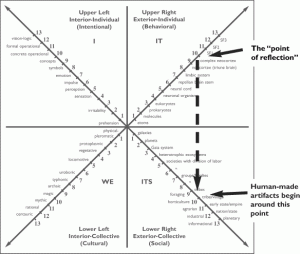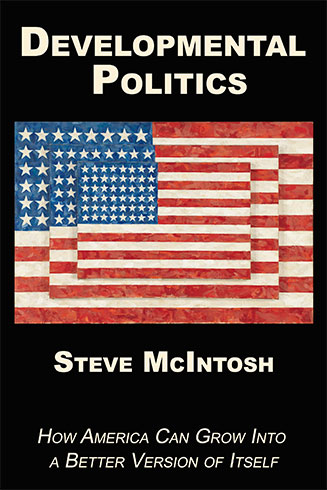Problematizing Interobjectivity: A Response to Edwards
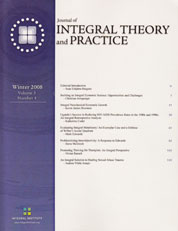 This article by Steve McIntosh was originally published in winter 2008 in The Journal of Integral Theory and Practice, Volume 3, Issue 4. It offers a constructive critique of Ken Wilber’s Four-Quadrant Model of evolutionary emergence.
This article by Steve McIntosh was originally published in winter 2008 in The Journal of Integral Theory and Practice, Volume 3, Issue 4. It offers a constructive critique of Ken Wilber’s Four-Quadrant Model of evolutionary emergence.
Abstract This article examines the subject of interobjectivity—the domain of evolution mapped by the lower-right quadrant of Ken Wilber’s four-quadrant model of evolution. Framed as a response to a critique of my previous work by integral theorist Mark Edwards, the article examines the problems associated with the integration of the concept of artifacts into the quadrant model’s holonic timelines of development. I focus on the systems theory of social autopoiesis to show why an accurate understanding of intersubjectivity and the role of artifacts in human evolution requires a revision in our thinking about the interobjective domain.
Key Words: interobjective; intersubjective; artifacts; social holons; cultural evolution
Introduction
At the recent Integral Theory In Action conference, held at John F. Kennedy University, I had the pleasure to meet distinguished integral theorist Mark Edwards. Edwards shared a draft of an article he had written for this journal, which critiqued “Appendix B” of my book, Integral Consciousness and the Future of Evolution.1 Appendix B, entitled: “Consideration of Wilber’s Four-Quadrant Model of Evolution,” expressed my concerns about the AQAL model’s integration of human artifacts into the timeline of evolutionary development. Appendix B offered a critique of the quadrant model, which I hoped would spark a scholarly debate about the issues raised.
Edwards’ thoughtful article, entitled: “Evaluating Integral Metatheory: An Exemplar Case and a Defense of Wilber’s Social Quadrant,”2 initiates such a scholarly debate and provides an excellent opportunity to respond and clarify my thinking in this area. The first half of Edwards’ article consists of an overview of his excellent work in the field of “scientific metatheorizing,” or theorizing about theories. He then uses this framework in an attempt to show how my critique of interobjectivity and the lower-left quadrant falls short.
My main purpose in writing this response is not to suggest that the quadrant model is invalid. This important model has obviously provided the foundation of integral theory for many years, and a growing body of valuable scholarship continues to be built around it. When I read on-line articles that offer critiques of the quadrant model, they often make me groan. These critics want to either expand the model so as to make it unruly and significantly less useful, or they want to quibble over perceived technical difficulties. So I should say up-front that the critique offered in Appendix B, and expanded in this article, is more fundamental, arguing that the quadrant model contains a crucial weakness that until now has gone unexamined. Nevertheless, I believe that the work of wrestling with this difficult issue of interobjectivity and “social autopoiesis” will ultimately strengthen our understanding of evolving systems and the usefulness of the quadrant model in general.
Edwards makes a good effort at summarizing my arguments in Appendix B. Although certain points are distorted or underemphasized, this is probably due in part to an original lack of clarity on my part. So in this article I will elucidate my position beginning with an explanation of the significance of what I consider to be the quadrant model’s most important innovation/discovery—the framing of “ontological” intersubjectivity. From there I examine the upper-right quadrant’s timeline of brain development in humans beyond fulcrum 10, labeled as “complex neo-cortex.” Then turning from the upper-right quadrant to the lower-right, I discuss the distinction between holons and artifacts, as originally brought to light by Fred Kofman3. Next I examine Wilber’s 2003 revisions to his theory, which attempted to incorporate the concept of artifacts. After explaining the problems associated with integrating artifacts into the quadrants’ holonic timelines of development, I then begin to address Edwards’ specific critiques of Appendix B. The article then focuses on the heart of the problem—social autopoiesis and the impact of the theory of ontological intersubjectivity on systems-theoretical conceptions of society. In the final section I describe how the interobjective quadrant continues to be useful, but commend integralists to be more flexible in their understanding of the interior universe and its relationship to the exterior world.
The Discovery of Ontological Intersubjectivity
In chapter 7 of Integral Consciousness I praise Wilber’s historically significant achievement in the framing of evolution through the use of his quadrant model, writing that: “Wilber’s four-quadrant model reveals aspects of reality that heretofore have not been fully recognized or understood, and so in certain respects this new frame of reality does for the internal [interior] universe what Descartes’ philosophy did for the external universe during the Enlightenment.”4 In my experience, I have found that the most useful and profound aspect of the quadrant model is its depiction of what I call ontological intersubjectivity. Although the idea of intersubjectivity originates with the philosophy of phenomenology, and although it has been further discussed and developed by philosophers such as Martin Buber and Jürgen Habermas, Wilber’s model achieves a significant philosophical breakthrough by showing how intersubjective structures are actually real holarchical systems evolving within a real domain of evolution. Wilber’s postmetaphysical theorizing about the central role of perspectives and the problem of the myth of the given explains that the ontology of these internal structures are not simply pregiven—Wilber is clear that their “existence” is partially dependent on a perspective with the appropriate “altitude.” But regardless of whether they “subsist” or “ex-ist,” the ontology of intersubjective structures is nevertheless an “intrinsic feature” of Wilber’s philosophy. So in practice, what distinguishes Wilber’s philosophy of intersubjectivity from the linguistically bound intersubjective philosophy of Habermas, is the way Wilber clearly identifies the holonic system-structures which comprise the evolving interiors of culture. Indeed, one of the primary moves that contributed to Wilber’s breakthrough was his elegant integration of systems science into the canon of evolutionary philosophy. Yet it is the inclusion of an aspect of this same system science that in my opinion currently burdens the quadrant model with a category error.
My point here is that the powerful idea of ontological intersubjectivity is new. It has not yet really been considered or applied by mainstream systems scientists, sociologists, or philosophers. So the implications of ontological intersubjectivity—the impact of the discovery of the intersubjective domain of evolution—are only just now being worked out. Thus far, the scholars testing and applying the theory are primarily those working within the nascent integral movement. And these integral scholars have, for the most part, simply accepted Wilber’s quadrant model as true and accurate.
Biological Evolution in the Upper-Right Quadrant
Part of what makes the quadrant model so compelling is its symmetry, its beauty, and its elegance. And this can be seen most powerfully in the symmetrical timelines of evolutionary development prior to the emergence of humans. As shown in Figure 1, before the appearance of human culture, Wilber’s fourfold timeline of development, which traces the evolution of both cosmological and biological structures, does reveal systems that are indeed interobjective holons (or perhaps more accurately, four-quadrant holons that clearly extend into the interobjective worldspace). These pre-human evolutionary structures are natural, self-organizing systems that are collective in nature and also externally visible. Therefore, we can recognize that the external structures found in the lower-right quadrant of Figure 1 are unquestionably authentic holons—products of the natural process of evolution. Ready examples of these external, interobjective structures can be found in organizations such as flocks of geese or families of apes.
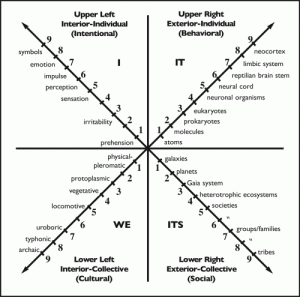
Figure 1. A valid four-quadrant diagram of evolution prior to the appearance of humans showing the lower-right quadrant ending with “tribes” and the upper-right quadrant ending with “neocortex.”
However, as illustrated in Figure 2, when we look closely at the extended timelines of holonic development, something changes at what Pierre Teilhard de Chardin called the “point of reflection”—the point in evolution when consciousness becomes conscious of itself. We can see this change in both the upper-right and lower-right quadrants. So we will begin this timeline analysis in the upper-right quadrant, and then come to what I see as the central problem in the lower-right quadrant in the next section, below.
Figure 2 points out how the evolution of major new biological structures in the human brain effectively stops at “complex neocortex” (at the point Wilber labels fulcrum 10). Nevertheless, Wilber’s model shows evolution continuing through “SF1, SF2, and SF3” (with “SF” standing for structure-functions in the human brain). By including these “post-complex neocortex” brain developments in the timeline of evolution in the upper-right quadrant, Wilber is trying to show how the emergence of new cultural worldviews have developmental counterparts in the brain (which include electrical, bio-chemical, and subtle energy developments). And I agree that the evolution of consciousness by stages does result in increased neurological activation in the brain. Thus I think Wilber’s model correctly accounts for this through his “structure-function” designations.
However, as I’m sure Wilber would agree, there is a significant difference between the emergence of major structures in the brain, which required long periods of biological evolution for their development, and the more modest developments designated by the structure-function fulcrums. I emphasize this in Appendix B, claiming that “Science is clear that the biology of the human brain has not evolved any new structures in at least the last 10,000 years; so whatever these structure-functions are, they do not constitute the evolutionary emergence of new biological structures (such as those shown along the upper-right quadrant’s timeline prior to “complex neocortex”).”5 Edwards takes me to task for this statement, citing scientific research which concludes that “there is no compelling reason to assume anything other than a reasonably constant trend towards increasing brain size over time.”6 Although I was careful not to say that there has been “no evolution of the human brain,” just no new brain structures in the last 10,000 years, I can see how my argument could be read in this way, and from this reading, Edwards’ critique is valid—the human brain has been continuously evolving since prehistory.
My argument would have been clearer if I had said that whatever biological evolution the brain may have gone through in the last 10,000 years, this cannot by itself account for the tremendous evolution of human consciousness during this the same period. That is, one of the most profound and amazing features of human consciousness is that it can evolve in ways that are not dependent on biological evolution. Before the appearance of humans, an organism’s interior mind and exterior brain evolved together in lockstep. For an animal to become appreciably smarter it has to evolve biologically. But with the advent of humans, the interior domain of consciousness is partially liberated from its biological constraints and is able to embark on the path of an entirely new type of mental, emotional, and spiritual evolution.
Whether those who live in developed societies have minds that are “more evolved” than humans who lived in the Stone Age is certainly controversial. But it seems to me that the amount and complexity of information—the sheer number of words and images—processed by the average citizen in the developed world is orders of magnitude greater than the quantity of information processed by our prehistoric ancestors. And not only are most modern humans conscious of a greater quantity of information, they are also conscious of fine distinctions of quality that would have been lost to their forebears. A modern human’s sense of smell or ability to recognize animal tracks may be less than her ancestors, but her ability to discriminate the myriad types of aesthetic experience available today is unquestionably more complex—her access to food, music, art, media, travel, and technology give her a range and degree of choices that are significantly greater than those available to people who lived in the Stone Age.
Moreover, educated moderns have a conceptual ability that is not found in tribal peoples; moderns are able to think about themselves and their society from enlarged perspectives that Stone Age peoples do not have. A number of studies7 involving extensive interviews with contemporary indigenous tribal peoples confirm that their thinking and perceiving is largely “representational,” that the words they use can usually only match individual objects, not entire categories or larger, more general types of phenomena. This research indicates that the consciousness found in most tribal peoples is not capable of thinking in syllogisms or logical types. Comparisons between objects are generally made on the basis of physical attributes with functional or conceptual similarities being largely ignored. This research does not suggest that there are any biological or racial differences between peoples who live “in different times in history,” but it does provide evidence that there are significant, measurable differences in the development of their respective stages of consciousness. Indeed, a central tenet of integral philosophy is that consciousness evolves. And my point in Appendix B is that the astounding development in human consciousness that has occurred in the last 10,000 years is not the product of biological evolution alone.
However, there are nevertheless definite exterior developmental counterparts, which connect with and correspond to this interior evolution of consciousness. Another central tenet of integral philosophy is that the “inside” and the “outside” co-evolve together. This was well-recognized by Teilhard de Chardin in his famous law of complexity-consciousness, which holds that consciousness develops in direct proportion to an organism’s organizational complexity. According to Teilhard, “complexification due to the growth of consciousness, or consciousness the outcome of complexity: experimentally the two terms are inseparable.”8 Yet, in his recognition of evolution beyond the biosphere—in the realm of the noosphere, in the post-reflection timelines of development—Teilhard also claimed that the material, human-made artifacts of society serve to supply the additional physical complexity that is required for consciousness to evolve beyond the animal level. Again, according to Teilhard (and integral philosophy in general) whenever interior consciousness evolves, it always requires a corresponding evolution in the complexity of the exterior structures associated with it. And as human consciousness advances within the developing noosphere, the corresponding development of human social artifacts, such as words and images, tools, social organizations, and architecture, “stand in” for the lack of significant biological development, thereby supporting the growth of consciousness with artificial (non-biological) physical complexity. Teilhard showed how human cultural evolution is always accompanied by a corresponding development in artifacts, which are thus recognized as indispensable aspects of all human cultural evolution. And I should emphasize here that the indispensible role of human-made artifacts in the evolution of human consciousness is a crucial point that is central to all the arguments that follow.
Wilber’s quadrant model builds on Teilhard’s law of complexity-consciousness and correctly indicates that the interior evolution in human consciousness necessarily corresponds to developmental counterparts in the brain, designated by the “SF” stages at the top of the timeline. Whether this increased brain activity can be seamlessly grafted onto the same timeline as the biological evolution that precedes it is arguable, but not particularly problematic. The real problem arises not from the discontinuity of biological evolution and increasing neurological activation in the upper-right, but in the discontinuity of interobjective pre-human biological groups and human-made social structures found along the timeline in the lower-right.
Holons, Heaps, and Artifacts
Continuing our consideration of Figure 2, when we turn our attention from the upper-right quadrant (the exterior-individual) to the lower-right quadrant (the exterior-collective), we find a similar but more profound kind of discontinuity in the timeline beginning at the point of reflection (or soon thereafter). The exact point in history when humans began to consciously design their social organizations is debatable,9 but by the time we get to the point of recorded human history, as I am about to argue, the externally visible physical forms of human social organization become unmistakably manmade—they are artifacts and not social holons.
But before we consider whether human social structures are artifacts or holons, it is worth asking up-front: why would this matter? What difference does it make whether the contents of the “exterior-collective” dimension of social evolution are holons or artifacts? Well, according to Wilber himself: “… the three words ‘whole,’ ‘part,’ and ‘hierarchy’ can apply to individual holons, social holons, artifacts, and heaps—but they mean something very different in each case, and we have to keep these differences in mind or we will commit all sorts of severe category errors, and these errors have grave and unfortunate consequences when pressed into social action and policy.”10 In other words, while human artifacts do develop and evolve as societies progress in the timeline of evolution, and while an understanding of artifacts is very important for any theory of cultural evolution, manmade structures play a different role in the process of development than do social holons, and they need to be recognized as distinct from the holarchy of naturally-arising social holons that Wilber’s model purports to map.
Wilber has acknowledged that when he first formulated the quadrant model in the early 1990s he was unaware of the important difference between holons and artifacts. In his original description of the quadrants, first published in 1995 in Sex, Ecology, Spirituality, Wilber correctly (if inadvertently) identified the post-reflection contents of the lower-right quadrant as human-made artifacts. This can be seen in the following quote from Sex, Ecology, Spirituality (in which I have underlined the obvious artifacts):
[I]n the Lower-Right quadrant, where evolution enters the human domain, I have only indicated the most concrete forms of geopolitical structures. But this quadrant includes the exterior of any of the social aspects of human interaction, including forces of production and techno-economic modes (bow and arrow, horticultural tools, agrarian implements, industrial machinery, computers, and so on), architectural structures, transportation systems, physical infrastructure, even written (material) forms of books, legal codes, linguistic structures, verbal signifiers, and so forth.11 [Underlining added]
This description, which identified the contents of the lower-right quadrant as essentially artifacts rather than holons, went unnoticed until integral theorist Fred Kofman pointed out the important difference between holons and artifacts in a 2001 article entitled “Holons, Heaps, and Artifacts.”12 But soon after the publication of Kofman’s article, Wilber did admit that his failure to distinguish between holons and artifacts in Sex, Ecology, Spirituality had been an oversight. This admission appeared in an interview Wilber posted on his publisher’s website13 which echoed Kofman’s analysis and thoroughly explained the difference between holons and artifacts. However, in this interview Wilber did not really explain whether or how this correction impacted his four-quadrant model.
Revisions to the Contents of the Interobjective Quadrant
Two years later, however, Wilber’s writing did begin to address the place of artifacts within his evolutionary model, thus modifying his position on the contents of the lower-right quadrant. Toward the end of “Excerpt D” to his forthcoming Volume 2 of the Kosmos Trilogy (published on the internet), Wilber explained that the lower-right quadrant actually contains both artifacts and what he called “behavioral intersections”:
Thus, when it comes to a social network (or system of its), those “it” items include both (1) the behavioral intersections of the members of the network and (2) the exterior artifacts that are the material components of the network. Both of those aspects are indeed “it” or “its.” The exterior behavior of an organism and the exterior artifacts are both third-person dimensions of being-in-the-world.14
Although Wilber’s more recent writing now acknowledges the place of artifacts, none of the graphical expressions of his model have been altered to show this significant revision. Moreover, Wilber has not addressed the problems that this revision creates for his central and continuing assertion that “all [individual] holons have four quadrants.”15 Wilber has used a variety of examples from the realm of biology to illustrate this theory, with the instance of a flock of geese being among the most recent. And if we consider the biological reality of geese (which can be located on his model’s timeline somewhere between fulcrums 7 and 8), we can indeed clearly recognize the consciousness of each goose in the upper-left quadrant, the brain and body of each goose in the upper-right quadrant, the holon of the flock of geese in the lower-right quadrant (as evidenced by their distinctive V-shaped flight formation), and the internal holon of the flock’s cultural community (literally the “pecking order”) in the lower-left quadrant. In this example the interior and the exterior of both the individual and the collective aspects of what it is to be a goose are all perfectly natural and holonic.
Again, the quadrant model works well when we are looking at biological evolution. However, when we consider the evolutionary structures found in the model’s timeline beyond fulcrum 10 (the approximate point of reflection), we can see that these exterior, visible, objective features of human collective social organization have all been clearly designed and produced through human effort and intention.
Recall that the right-hand side of Wilber’s quadrant model is defined as that which can be actually seen with the senses or otherwise detected through sensory-empirical scientific measurement. The contents of the objective and interobjective quadrants are said to have “simple location.” And when we look around us at the external society we live in, these outward manifestations of culture are indeed evident—they can be seen in words and images, architecture, technology, transportation systems, financial records, law codes, fashions, etc. These are the obvious exteriors of human culture, which Wilber originally and correctly identified in Sex, Ecology, Spirituality. However, once we recognize that the exterior aspects of all these social structures are artifacts and not holons, once we have to prop-up the idea interobjectivity by retreating to “behavioral intersections” to try to locate the supposedly natural, self-organizing objective systems that the model requires, the “simple location” of these postulated self-organizing systems becomes difficult to find.
Even though Wilber has since tried to nuance his position in this area by claiming that at the level of human societies his interobjective quadrant of evolution consists of both holons (behavioral intersections) and manmade artifacts, it is difficult to see how these supposed “behavioral intersections” by themselves have enough “systemic weight” to be identified as semi-independent autopoietic social holons. In our examination of the composition of human social systems, once we properly identify the exterior artifacts and the interior intersubjective holons, which together comprise these systems, the additional postulation of self-organizing exterior social holons becomes unnecessary.
As a clarifying example, we can see how the subjective complexity of human consciousness is intimately bound up with the marvelous physical complexity of the human body. The body’s astounding material complexity is intensely evident and often painfully obvious. And similarly, the evident intersubjective complexity of human culture is also bound up with the physical complexity of human society. But this evident and astounding material complexity of our evolving society is not found in the rather obscure and intangible notion of “behavioral intersections” engaging in “social autopoiesis,” it is found in the obvious societal constructions that surround and envelop us, such as the artifacts listed above. The collective exterior structures of the biosphere are the products of genetic design, they have arisen autopoietically and primarily through natural selection. But the physical complexity of the noosphere is primarily the product of actual selection, not natural selection. Indeed, it is because humans are able to design and create artifacts so much more effectively than animals that we have been able to intentionally extend the physical complexity of our society and evolve at a faster pace than biological evolution would otherwise allow.
As an example of the fundamental interaction of holons and artifacts in the evolution of culture and society, consider the function of human language. The development of language is a key factor that allows human consciousness to grow beyond its biological roots. But the development of language relies upon the creation of words, which are unquestionably human-made artifacts. While the interior meanings and agreements that every word stands for (known as the signifieds) are indeed subjective and intersubjective holons, the “signs” or words themselves (known as the linguistic signifiers) are always artifactual. Language as a whole is not a straightforward artifact constructed by humans like, say, a car or a road. Nevertheless, we can see how word “construction” allows language to expand.16 The English language, for example, has grown geometrically in the past 500 years as modernist consciousness has emerged.17 Modernists and postmodernists have created or consciously adopted hundreds of thousands of new words, and the growth of these words have simultaneously helped to co-create modernist and postmodern consciousness. Again, even though much of language is holonic and autopoietic, the words themselves are artifacts. In the case of a dead language, the words may still exist (carved on a tomb or building), but the words don’t continue to organize themselves or act as an autopoietic system once the people who speak the language die out. And this understanding of the way language arises through the combination of the social holons of agreement and the artifacts of words provides an excellent illustration of Teilhard’s insight about how natural psycho-cultural systems (holons) and material civilization (human-made artifacts) emerge together in the advance of noosphere evolution.
Returning to Edwards’ Arguments
After providing a partial summary of my arguments from Appendix B, Edwards proceeds to offer a series of refutations. The first of these points out that the human brain has continued to evolve since prehistory and that I am therefore mistaken in suggesting otherwise. This was addressed above—Edwards’ argument is well taken, but it is not entirely salient to my original point about human consciousness being able to evolve faster than its underlying biology.
In Edwards second argument he assigns to me the conclusion that “social evolution is essentially bio-cultural and the development of artifacts is epiphenomenal in terms of their capacity to self-organize.”18 In other words, he contends that my arguments necessarily result in the position that artifacts (and interobjective events in general) exert no causal efficacy on interiors. He later clarifies this point, writing: “Metatheory that sees all aspects of evolutionary development as essentially caused or designed by the dynamic unfolding of the subjective and the cultural suffers from a form of psychological developmentalism.”19
So in response to this I can heartily agree that any theory which denied that artifacts exert causal efficacy over the evolution of consciousness and culture would be woefully inadequate. However, I do not hold this. I think artifacts have a huge influence on internal development, and so I can agree with Edwards’ statement that “social artifacts and economic realities [are] fundamental to the development of consciousness and not just instruments or material extensions of some internal capacity.”20 As I mentioned at the beginning of this paper, I abide by the central tenet of integral philosophy that the interior and the exterior always co-evolve together.
Now, even though I never said (nor ever thought) that artifacts have no causal influence on evolution, I’m not accusing Edwards of using a straw man argument here. This is a difficult subject and it is very easy to get the wrong idea. But this is why a scholarly debate such as this is necessary to bring out the important nuances and to clarify the inevitable misunderstandings that arise as we try to get our arms around a thorny problem such as this.
My main point is that the relatively unique ability of humans to design and create artifacts is one of the primary mechanisms through which we gain control over our own evolution. Artifacts such as words are intentionally created and used to extend evolution, and so their causal efficacy is undeniable. And it is this intentional nature of artifacts that problemitizes the idea that this material extension of human evolution is somehow arising automatically (autopoietically) as part of a natural biological process without the critical factor of volitional design.
Proper Use of Metatheoretical Evidence for Social Autopoiesis
Edwards argues further that in denying the concept of social autopoiesis, I am violating the metatheoretical principle of “non-exclusion.” He contends that I am ignoring the “overwhelming unit-level evidence” found in “exteriorist, systems-based functionalist theories and inter-objective paradigms”21 According to Edwards, this means that my “metatheorizing” is merely speculative and not evidence-based. However, to claim that there is “overwhelming unit-level evidence” for social autopoiesis makes it sound like this is established science, rather than a controversial, even radical, postmodern sociological theory.
As most integralists know, the concept of autopoiesis originates in the field of biology through the work of Humberto Maturana and Francisco Varela, who hypothesized a generative mechanism through which an organism can continuously reproduce itself through a kind of circular organization wherein its outputs become its own inputs. Although the original concept of autopoiesis remains controversial within the realm of biology,22 it has been adopted by theorists in a wide variety of academic disciplines. Academic use of the concept outside of biology has varied widely, with its attempted application sometimes being “based on a very partial, if not unsound, reading of the original ideas.”23 In fact, neither Maturana nor Varela consider human social systems to be autopoietic, and the issue of how autopoiesis can or should be applied to social systems is an ongoing topic of debate.24
And this brings us to the work of social systems theorist Niklas Luhmann, who has been the main proponent of the application of autopoietic theory to sociology. Although other sociologists have utilized the concept of autopoiesis in their analysis of social systems, many of these theorists use the concept only as a metaphor, or see social systems as merely a medium in which the autopoiesis of individuals takes place.25 Luhmann, however, applies autopoiesis in the strictest sense, holding that “society” consists of a closed system of communication that reproduces itself in way that is independent from the thoughts, behaviors, actions, or intentions of people. Luhmann conceives society and its subsystems as an autopoietic network of recursive communicative events wherein the consciousness of people serve as merely the “environment” in which the communicative system operates. According to systems thinker John Mingers, in Luhmann’s theory, “society is essentially centerless—there is no core or fundamental division driving it, and there is no privileged position from which a rational overall view can be developed. Instead we have self-defined autonomous subsystems in a constant process of renewal and redefinition, locked together in a fragile balancing act, resonating among themselves but relatively unresponsive to society’s external environment.”26
I will affirm that Niklas Luhmann is an important theorist who recognizes the systemic nature of social evolution, and his work has been influential in academia. Yet like many postmodern theorists, Luhmann’s writing is highly abstract, and he offers very few examples or illustrations. Nevertheless, putting in the effort to read Luhmann is a worthwhile exercise for integralists because it really demonstrates the power of integral philosophy’s understanding of ontological intersubjectivity, and the corresponding inadequacy of social theories which fail to take this into account. That is, in the light of a systemic understanding of the lower-left quadrant, one can see how Luhmann is struggling to describe systemic behavior that is real, yet he doesn’t have a way of getting at it. The result is a reductionistic social theory that is far from integral, having been severely criticized for the way that it “effectively filters humans out of the system.”27 As Wilber himself has written, “[S]ociology has all too often confined its studies to this one component ([that which can be seen in] the LR quadrant) and been very distrustful of the study of anything other than monological, observable variables in a social action system.”28
Because social systems theorists like Luhmann do not adequately acknowledge cultural interiors, the subtle distinction between intersubjective cultural holons and the objective artifacts with which they are directly associated is completely missed. So it is not that these systems theorists are all wrong, it is just that they have not had the benefit of integral theory’s breakthrough discovery of ontological intersubjectivity in their analysis.29 They can recognize the authentic systemic behavior of human social systems, but they have not recognized that the self-organizing aspects (the social holonic aspects) of the systems they are trying to understand reside primarily in the interior universe. Again, I think the example of the interaction of social holons and artifacts in the generation of human language provides a good example of this process: The intersubjective agreement—the shared experience of the referent—provides the agreement that makes a given word’s communication of meaning possible, and the word itself reinforces the agreement and helps reproduce the experience that the word stands for. The intersubjective shared experience and the artifactual word often arise together. And it is in this way that artifacts (such as words) participate in the autopoiesis of social-cultural systems. But as I argued above, words by themselves are not autopoietic; their ability to self-organize depends on their connection to the underlying holonic interiors of culture.
According to my understanding of integral philosophy, artifacts cannot self-organize by themselves, they cannot become “dynamic Its” without the underlying dynamism of intersubjective human agreements. As another example, we can see how the stock market exhibits self-organizing systemic behavior. But when we look at the exteriors of a stock market—the computer files, the display boards, the exchange’s building and trading floor, and all the verbal and written communications that produce the trades—it is difficult to see how these material artifacts alone are somehow organizing themselves. Just as with language, it is the underlying human agreements—the holonic interiors—that give these manmade constructs the self-organizing “life” we identify as autopoietic. Some may argue that the autopoiesis of the stock market is found not in the computers and buildings, etc. but in the economic systems that comprise the market. Yet when we recall that the contents of the lower-right are defined as having “simple location”, we have to ask “where is the system”? Although there are certainly automatic mechanisms programmed into the stock market’s infrastructure, the system as a whole is intimately bound up with the decisions and actions of the people who make the market. The market system is made up of both intersubjective holons and objective artifacts. So without the people, without the subjective and intersubjective side of the equation, the “system” would not exist for long. The reason that the stock market exhibits autopoietic behavior, the reason it can behave in ways that are beyond our control, is because of its intersubjective aspect. It is the intersubjectivity that makes it holonic and autopoietic, and this enlarged understanding of intersubjective systems is one of the things that make integral philosophy so powerful.
Again, because social systems theorists do not take intersubjectivity into account adequately, they are left to construct theories of human society that can only recognize the exterior manifestations of the underlying intersubjective dynamism. And because these theorists are generally unwilling to consider any kind of metaphysics in their understanding (such as the metaphysics30 of ontological intersubjectivity), they find themselves resorting to a kind of “meta-biology” under which they attempt to understand the systems of human culture as though they were biological organisms or exterior ecosystems.
Systems science’s general lack of understanding of the intersubjective side of cultural evolution has been well pointed out by Jürgen Habermas, who conducted a series of famous debates with Luhmann in which he posited objections to Luhmann’s use of biological systems theory to try to understand society. According to Habermas, “Luhmann simply presupposes that the structures of intersubjectivity have collapsed …” Habermas continues: “Societies cannot be smoothly conceptualized as organic systems because their structural patterns are not accessible to observation; they have to be gotten at hermeneutically, that is, from the internal perspective of participants. The entities that are to be subsumed under system-theoretical concepts from the external perspective of the observer must be identified beforehand as the [intersubjective] lifeworlds of social groups. They must be understood in their symbolic structures.”31 In other words, according to Habermas, the systemic behavior of human social groups has a significant intersubjective component, so the attempt to understand society merely through systems theoretical views is mistakenly reductive. Contrary to Luhmann’s monological theory, the artifactual systems of communication that form the exteriors of human culture do not arise autopoietically by themselves like a biological ecosystem, they are always activated and sustained by the interior social holons of human agreement.
In his writing Wilber has clearly shown why social holons cannot be seamlessly grafted on top of individual holons in a continuous holarchical line of development (i.e. ecosystems are not simply “higher level organisms”). However, his theory has not adequately dealt with a similar problem that arises when you try to stack the noosphere on top of the biosphere within the interobjective quadrant of development. Recognizing the difference between social holons and individual holons is crucial for integral theory; and it is just as crucial that we also clearly recognize the difference between interobjective biological holons (such as flocks of geese) and consciously designed human social organizations (such as divisions of soldiers). Indeed, it is because of our unique ability to construct complex artifactual structures that humans have been able to achieve accelerated social development and ongoing cultural evolution.32
So in response to Edwards’ critique that I am ignoring the evidence of social autopoiesis theory, I can respond that I have not ignored it. Rather, I have tried to use the shortcomings in this theory to help better understand the territory that the quadrants purport to map. To reject certain theories as inadequate does not violate the principles of scientific metatheorizing, because if that were the case we would likewise not be able to reject the “overwhelming unit-level evidence” for the theory that the universe is simply “matter in motion.”
The Remains of Interobjectivity
In his final critique, Edwards concludes that I am trying to use the principles of parsimony (which I invoke using Ockham’s razor) to remove the interobjective quadrant from Wilber’s model. Edwards writes:
Consequently, proposing that the social quadrant can be removed from the AQAL metatheory means that a parsimonious account of reality has no need for explanations based on interobjectivity. In other words, interobjective events have no causal power in their own right. What happens in the social world is derivative of, and can always be explained by, interior intentional or cultural factors.33
With respect to this assertion I can respond by repeating that I am not denying that the collective exteriors of society are real or that they certainly have causal efficacy on subjective and intersubjective interiors. I merely contend that the exterior counterparts of intersubjective human cultural structures are usually best conceived of as simply objective.
As I have explained, the concept of interobjectivity (which originates with Wilber) is a completely valid aspect of the evolution of cosmology and biology. And as such, its extension into the analysis of human cultural-social evolution can be useful. However, as I have argued, non-holonic, manmade artifacts provide the method by which humans have been able to intentionally extend their exterior physical complexity (both individual and collective) so as to develop in ways that transcend biological evolution. And because artifacts and social holons cannot be smoothly charted in the same developmental line, this causes problems for the lower-right quadrant of the model beyond the “point of reflection.” Moreover, proper recognition of this non-holonic developmental line of exterior artifactual growth blurs the distinction between singular “objective” and plural “interobjective.” That is, artifacts are both individual and collective, and it is difficult to draw hard lines between their “upper” and “lower” quadratic locations.
Now, acknowledging Edwards’ concerns, perhaps I did go too far in Appendix B, because I do believe that the theory of interobjectivity has continuing value. In fact, I do employ four-quadrant analyses in Integral Consciousness, but my diagrams show artifacts in the lower-right quadrant. Figures 3 and 4, below, thus provide an example of how interobjectivity can be compatible with an understanding of cultural evolution that rejects the theory of social autopoiesis and “dynamic Its,” and sees how manmade artifacts, such as words and images, art, technology, institutions, and organizations, are the actual, visible, intentionally designed exteriors of human culture.
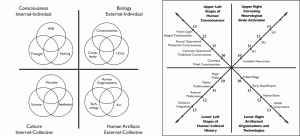
Figures 3. and 4. Examples of four-quadrant analyses incorporating artifacts, from: Integral Consciousness and the Future of Evolution.
Therefore, because the lower-right quadrant can continue to be used, this article’s attempt to “problemitize” interobjective social holons need not be overly disruptive of integral scholarship. In fact, most integralists are already inadvertently using the quadrants in this way. When people talk about the systems of the lower-right quadrant they usually end up describing the artifactual systems of society. Thus, the problem is not with the quadrants per se, it is with Wilber’s continuing assertion that, beyond the point of reflection, the lower-right quadrant continues to be populated by exterior “Its”—self-organizing, autopoetic, exterior social holons. However, once we look closely at the essential role of artifacts and the weakness of the theory of social autopoiesis, we can see that human cultural evolution (like language itself) is partially holonic and partially artifactual— and thus the “interobjective aspect” of social evolution, the exteriors of our civilization, are properly conceived not as autopoietic holonic systems, but as the human constructions of our society with which we are familiar.
My purpose in critiquing the weaknesses of the theory of interobjectivity is not to eliminate the quadrants as a theoretical tool or map. Rather, my aim is to simply help the integral community hold onto this model less tightly and use it less dogmatically. As I argue in Integral Consciousness, sometimes a four-domain analysis (employing the quadrants) is most illuminating, but in other situations a three-domain understanding (using the “Big Three” of nature, self, and culture) can be more accurate. And this is in fact how Wilber himself often uses integral theory. In his writing Wilber frequently reduces the four quadrants to simply the “Three Big” domains: objective, subjective, and intersubjective. The individual and collective aspects of the “right hand,” exterior side of his model are collapsed into a single domain, with the individual objective and the collective interobjective—“It and Its”—become simply “It.” And it is by reducing these two exterior quadrants to one single domain that Wilber has been able to connect his model of reality to the heritage of many of the world’s greatest thinkers who have consistently recognized, in one form or another, these three basic domains of reality.
There are actually a variety of ways that we can conceive and graphically express our new understanding of the internal universe and its relationship to the external world. Figures 4 and 5 (taken from, and explained in Integral Consciousness34) provide examples of other, complementary ways we can diagram or chart the essential elements of the integral reality frame. This is not to suggest that these graphical expressions of evolution are in any way superior to the quadrant model, they have their own weaknesses and cannot replace the quadrants as a map. These graphics do, however, suggest that as proponents of integral theory we would do well to employ a variety of maps and models in our important task of demonstrating the enlarged understanding of evolution provided by integral philosophy.
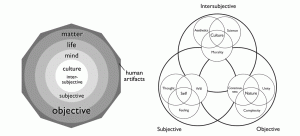
Figures 5. and 6. Other possible ways to view the relationship between the interior and exterior universe.
Conclusion
As I discuss in Integral Consciousness, I am indebted to Ken Wilber for his marvelous formulation of the quadrant model. And I am grateful for Edwards’ considerate critique of my work and defense of the lower-right quadrant. I also wish to thank Sean Esbjörn-Hargens and Zachary Stein for their thoughtful comments on this paper. The theory of interobjectivity is an important aspect of integral philosophy that deserves the kind of careful and rigorous evaluation that can only come from an engaged and constructive debate. Edwards’ article has thus stimulated such a debate, to which I am sure he could add still more. Our exchange will hopefully continue here and elsewhere as we do the important work of advancing our grasp on the integral theory of evolution.
At the very least, I have tried to show that, as with any map, the quadrant model contains distortions and simplifications; but these problems do not render it completely invalid. Like just about every aspect of integral philosophy, Wilber’s four-quadrant map is true but partial. Even after we have corrected the mistaken assertion that in the noosphere “all holons have four quadrants,” the quadrant model remains an important conceptual framework for understanding the inside and the outside of the individual and collective aspects of evolution. However, as integral philosophy evolves and begins to occupy a larger position in the marketplace of ideas, I think we need to better understand the limitations and weaknesses of this important model, so that over-reliance on it does not undermine the credibility of integral philosophy as a whole.
NOTES
1. McIntosh, Integral Consciousness, p. 324-342.
2. Edwards, M. “Evaluating Integral Metatheory: An Exemplar Case and a Defense of Wilber’s Social Quadrant,” in The Journal of Integral Theory and Practice, Vol. 3, Issue (4), December, 2008.
3. Kofman, F. Holons, Heaps and Artifacts, 2001, Published on: http://www.integralworld.net.
4. McIntosh, Integral Consciousness, p. 191.
5. McIntosh, Integral Consciousness, p. 327.
6. Edwards, “Evaluating Integral Metatheory”, section 4.1.
7. See Wade (1995) p. 77-96, Wilber (1995) p. 169-176. See also Habermas, (1979), McCarthy (1978), Luria (1976), Lundberg (1974), Scribner and Cole (1981), Werner (1940/1980), Levy-Bruhl (1910/1985).
8. Teilhard de Chardin, The Future of Man, p. 174.
9. An interesting area for further research and theory building centers on the interpenetration of holons and artifacts in early human organizational structures. For example, the family is a largely holonic social structure inherited from the animal world. Yet the modern family certainly contains many conventions and structural relationships that are manmade. Tribal structures appear to be partially holonic (based on biological kinship and the extended family) and partially artifactual (incorporating rituals and functional roles that have been consciously designed by humans). However, these traces of natural, interobjective social organization diminish as human society evolves beyond the tribal stage.
10. Wilber, K. On Critics, Integral Institute, My Recent Writing, and Other Matters of Little Consequence: A Shambhala Interview with Ken Wilber, Published on: http://wilber.shambhala.com.
11. Wilber, Sex, Ecology, Spirituality, p. 197.
12. Kofman, F. Holons, Heaps and Artifacts, 2001, Published on: http://www.integralworld.net.
13. Wilber, K. On Critics, Integral Institute, My Recent Writing, and Other Matters of Little Consequence: A Shambhala Interview with Ken Wilber, Published on: http://wilber.shambhala.com.
14. Wilber, Excerpt D, Part IV, page 3, Volume 2 of The Kosmos Trilogy, Quoted paragraph ends with note 52. Published on: http://wilber.shambhala.com.
15. Wilber, Integral Spirituality, p. 172. I have inserted the bracketed word “individual” in this quote because, despite this recent blanket statement, Wilber has argued that although individual holons have four quadrant social holons do not.
16. Some animals use rudimentary forms of language (such as the complex communication by whistles seen in prairie dog colonies), but the use of language by animals does not allow their culture to continuously evolve as it does with humans. Once established, animal languages remain relatively unchanged from generation to generation. Human language, however, has shown the ability to rapidly develop through the creation of new words—new artifacts.
17. See e.g., The Global Language Monitor, which claims that English now has close to one million words: http://www.languagemonitor.com
18. Edwards, “Evaluating Integral Metatheory”, section 4.2.
19. Edwards, ibid, section 5.
20. Edwards, ibid, section 4.2.
21. Edwards, ibid, section 4.2.
22. See Mingers, Self Producing Systems, p. 119-152.
23. See Mingers, ibid, p. ix.
24. cf, the social system scholarship in these references: Zeleny, 1980; Benseler, Hejl & Kock, 1980; Ulrich & Probst, 1984; and Mingers, 1995.
25. See Mingers, Self Producing Systems, p. 120-125.
26. Mingers, ibid, p. 148.
27. Quoted from the on-line essay: “Autopoietic Theory and Social Systems: Theory and Practice,” retrieved from: http://oldwww.acm.org/sigs/sigois/auto/AT&Soc.html.
28. Wilber, Sex, Ecology, Spirituality, p. 129.
29. In the quote cited in endnote 4, I emphasize that the “four-quadrant model reveals aspects of reality that heretofore have not been fully recognized or understood …” In other words, once we adopt the understanding of the interior universe revealed by integral philosophy, this changes or modifies the meanings of words such as “system” and “artifact.” Thus, one could argue that the problem I am highlighting is simply a matter of semantics, and that the definitional difference between a holon and an artifact is a relic of “pre-quadratic” thinking. Perhaps we should define “artifacts” as “going all the way down;” perhaps a v-shaped flight formation of geese is actually an artifact, and that all holons have an artifactual component. However, refining our terms to include this meaning would signal a change from Wilber’s stated positions cited in endnotes 10 and 14, and would imply a distinct refinement of integral theory. Moreover, I think that there is an important difference between artifacts designed by self-conscious humans (which become a causal factor in cultural evolution) and artifacts “designed” by animals that lack self-consciousness (with such animal artifacts having no significant causal efficacy in the evolution of animal “culture”).
30. As explained in Integral Consciousness, I characterize Wilber’s recognition of the intersubjective domain of evolution as a kind of “metaphysics”. Not the bad, unevidenced kind of metaphysics rejected by professional philosophy, but metaphysics nonetheless. See Integral Consciousness, p. 208-216.
31. Bausch, Emerging Consensus in Social Systems Theory, p. 88.
32. Animals do make and use artifacts, but the use of artifacts by animals does not generally cause their society and culture to dramatically evolve. However, as I have argued, humans’ ability to make complex artifacts is a significant factor in the unprecedented evolution of human society and culture.
33. Edwards, “Evaluating Integral Metatheory”, section 4.4.
34. See, McIntosh, Integral Consciousness, p. 21-22 and p. 277-307. Figure 5 shows “development by envelopment,” depicting how intersubjective culture exists, in a way, “in-between” subjects. This model thus shows how intersubjectivity is the “most internal” with manmade artifacts (having no holonic interiors) being the “most external.” Figure 6 charts my description of the dialectic directions of evolution, showing how this three-fold pattern is self-similar—it shapes each domain as well as the containing structure of the “Big Three” domains themselves.
REFERENCES
Bausch, K. C. (2001) The Emerging Consensus in Social Systems Theory. London: Kluwer Academic/Plenum Publishers.
Benseler, F., Hejl, P., & Kock W. (eds.) (1980). Autopoiesis, communication, and society: The theory of autopoietic systems in the social sciences. Frankfurt: Campus Verlag.
Edwards, M. (2008) Evaluating Integral Metatheory: An Exemplar Case and a Defense of Wilber’s Social Quadrant. The Journal of Integral Theory and Practice, Vol. 3, Issue (4).
Habermas, J. (1987) The Philosophical Discourse of Modernity. Cambridge: MIT Press.
Habermas, J. (1979) Communication and the Evolution of Society. Boston: Beacon Press.
Kofman, F. (2001) Holons, Heaps and Artifacts. Retrieved from: http://www.integralworld.net.
Levy-Bruhl, L. (1985) How natives think. Princeton: Princeton University Press (Originally published 1910).
Luhmann, N. (1995) Social Systems. Stanford: Stanford University Press.
Lundberg, M. J. (1974) The incomplete adult: Social class constraints on personal development. Westport, CT: Greenwood.
Luria, A.R. (1976) Cognitive Development: Its cultural and social foundations. Cambridge: Harvard University Press.
McCarthy, T. (1978) The Critical Theory of Jurgen Habermas. Cambridge: MIT Press.
McIntosh, S. (2007) Integral Consciousness and the Future of Evolution. St Paul: Paragon House.
Mingers, J. (1995) Self-Producing Systems; Implications and Applications of Autopoiesis. New York: Plenum Publishing.
Scribner, S. & Cole, M. (1981) The psychology of literacy. Cambridge: Harvard University Press.
Seidl, D., & Helge Becker, K. (eds.) (2005) Niklas Luhmann and Organization Studies. Oxfordshire: Liber & Copenhagen Business School Press.
Teilhard de Chardin, P. (1955) The Phenomenon of Man. New York: Harper and Row.
Teilhard de Chardin, P. (1964) The Future of Man. New York: Harper and Row.
Ulrich, H., and Probst, G. J. B. (eds.) (1984)
Self-Organization and Management of Social Systems: Insights, Promises, Doubts, and Questions.
London: Springer-Verlag.
Wade, J. (1995) Changes of Mind, A Holonomic Theory of the Evolution of Consciousness. Albany: SUNY.
Werner, H. (1980) Comparative psychology of mental development. New York: International University Press (Originally published 1940).
Wilber, K. (1995) Sex, Ecology, Spirituality. Boston: Shambhala.
Wilber, K. (2001) On Critics, Integral Institute, My Recent Writing, and Other Matters of Little Consequence: A Shambhala Interview with Ken Wilber. Retrieved from:
http://wilber.shambhala.com.
Wilber, K. (2003) Excerpt D, Part IV, page 3, Volume 2 of The Kosmos Trilogy. Retrieved from: http://wilber.shambhala.com
Wilber, K. (2006) Integral Spirituality. Boston: Integral Books/Shambhala.
Zeleny, M. (ed.) (1980). Autopoiesis, Dissipative Structures, and Spontaneous Social Orders. AAAS Selected Symposium 55 (AAAS National Annual Meeting, Houston TX, Jan. 3-8, 1979). Boulder, CO: Westview Press.
